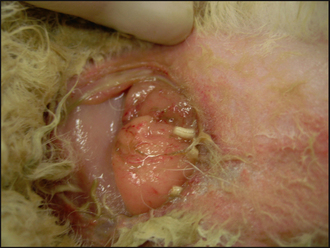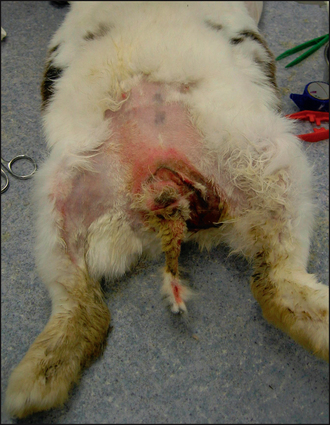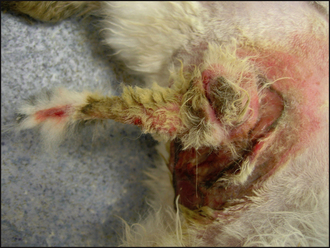38 Fly strike in a rabbit (myiasis)
CASE HISTORY
In this case the relevant history was:
CLINICAL EXAMINATION
Thorough examination of the perineal region revealed maggots and lesions consistent with fly strike. The skin around the perineum, inguinal area and tail base was grossly inflamed, moist and exudative (Fig. 38.1). There was faecal and urine contamination of the area, causing matting of the fur in places (Fig. 38.2). Stage L1–L3 maggots were seen, suggesting that initial egg laying occurred at least 40 hours ago (Table 38.1). Several skin wounds were found in the perineal and tail base area, with L2 and L3 stage maggots moving in and out of these wounds (Fig. 38.3).

Figure 38.3 L3 maggots in the wound. Careful examination and removal are required to ensure none are missed.
Careful and systematic examination, particularly around the tail base, perineum and inguinal area, is required to avoid missing early cases of myiasis. A common site for maggots to feed is in the two deep folds of skin either side of the anal orifice. These are the inguinal glands and in the healthy rabbit are normally filled with a yellow–brown odiferous deposit. The L1 stage maggots are only a few millimetres in length and can be missed during a brief examination. These larvae only feed on skin debris and exudate, and so will cause mild inflammation, but not gross skin damage alone. Clumps of small eggs, looking like grains of rice, may be seen within the coat. In older cases of myiasis, larger second- and third-stage larvae will be present, which will be easier to see and are likely to be associated with more severe soft tissue damage.
The perineum is a very sensitive area and conscious examination should be kept brief, simply to assess the degree of damage. For more detailed examination and treatment, sedation or general anaesthesia (Table 38.2) must be used.
Table 38.2 Anaesthetic protocols for fly-struck rabbits
| Anaesthetic agent(s) | Dose | Notes |
|---|---|---|
| Fentanyl/fluanisone | 0.2–0.3 ml/kg i.m. | • General anaesthesia can subsequently be induced with midazolam (0.5–2 mg/kg i.v.) to effect, or isoflurane by mask • Long recovery (3–6 h) but can be shortened by antagonizing with buprenorphine (0.01–0.05 mg/kg i.m.) or butorphanol (0.1–0.5 mg/kg i.m.) |
| Midazolam | 0.5–2.0 mg/kg i.v. | |
| Medetomidine and ketamine | ||
| Medetomidine, ketamine and butorphanol | ||
| Fentanyl/fluanisone and isoflurane (Isoflo; Abbots) | (F/F) 0.3 ml/kg i.m., then mask induction with isoflurane | |
| Fentanyl/fluanisone and midazolam | (F/F) 0.3 ml/kg i.m., then (M) 0.5–2 mg/kg i.v. 10–20 min later | |
| Isoflurane or sevoflurane only | Either starting on 1% and increasing by 0.5% every few minutes, or start with 5% for isoflurane or 8% for sevoflurane | • Used for anaesthesia of critically ill rabbits, who tend not to struggle or breath-hold with mask induction |
| Propofol | 10 mg/kg IV |
Clinical signs of myiasis in rabbits include:
Candidates and criteria for considering euthanasia would include:






